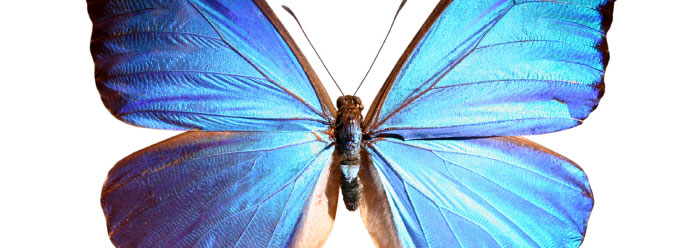The strikingly iridescent blue seen in some butterfly, beetle, and bird feathers is well-known and enjoyed by scientists and laymen alike. This is due to creatures (and some plants) reflecting or absorbing certain frequencies of light due to the external chemical composition of their body. In past decades, it has been realized that although the color of these structures is clearly and unusually blue—no blue pigment can be found!
The South American butterfly, Morpho rhetenor, has wings composed of extremely tiny scales like all members of the Lepidoptera. Biologists magnified scales of the upper wing surface 20,000 times and saw "a regular grid of precisely constructed wedge-shaped ridges spaced at intervals of about 0.00022 mm. This pattern is repeated so accurately that the maximum deviation is only 0.00002 mm. No earthly workshop specializing in miniaturization [nanotechnology], would be able to make one single wing scale with this required precision."1 Detailed investigation of other butterflies reveals iridescence due to "nanoscale structures that produce ultra-high reflectivity and narrow-band spectral purity."2
The beautiful colors of male peacock plumes are due to variations in the photonic lattices. These are found at the nanoscale level in the tiny barbules of the magnificent feathers.
Beetles of the genus Hoplia found in France have chitin sheets (a stiff polysaccharide) in the scales of its exocuticle.3 The light is reflected due to a sophisticated network of airspace and rods of chitin. The title of this particular article says it all, "Blue beetle has natural nanophotonic design." Creation scientists heartily agree and would add that the design they speak of means a Designer.
Sadly, we find once again that scientists ignore the clear case for creation and simply say that millions of years ago, "biological systems were using nanometer-scale architectures to produce striking optical effects."4 The two authors use the word "remarkable" several times to describe various photonic structures, but at the end of the article state that they have assembled themselves. This is hardly a scientific explanation, of course.
At the end of one article, the author says ". . . Nature may be able to teach scientists a new approach to the fabrication of technologically useful photonic structures."5 The creation scientist gives glory not to "Nature," but to the One true Creator. We can indeed learn from Him as we investigate His living creation.
References
- Gitt, W. 1997. In the Beginning was Information. Christliche Literatur-Verbreitung, p. 15.
- Vukusic, P., et al. March 1, 2001. Now you see it—now you don't. Nature, v. 410, p. 36.
- Harper, R. February 2006. Blue beetle has natural nanophotonic design. Biophotonics, v. 13, p. 22.
- Vukusic P. and J. Roy Sambles. August 14, 2003. Photonic structures in biology. Nature, v. 424, p. 852.
- Blau, S. January 2004. Light as a Feather. Physics Today Online, www.physicstoday.org.
* Frank Sherwin is a zoologist and seminar speaker for ICR.





















